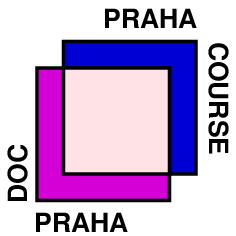
DOCCOURSE PRAGUE 2005
Programme for pre-doctoral and doctoral students in
Modern Methods in Ramsey Theory
Prague, January 5 - March 31, 2005


|
DOCCOURSE PRAGUE 2005Programme for pre-doctoral and doctoral students inModern Methods in Ramsey TheoryPrague, January 5 - March 31, 2005 |

|
Supported by the EU network COMBSTRU and by DIMATIA Prague.
Lectures (Monday and Tuesday, 9-12):
Weeks 1-2: Ehud Friedgut, Jerusalem
All lectures are held in S5 (2nd floor) unless noted otherwise.
Miklos Simonovits,Turan Problems, Ramsey Problems, Simple and Random-looking Extremal Structures
 and an integer r => 2.
and an integer r => 2.

 ?
?

 ?
?

 ?
?

 ?
?

Abstract:
Ramsey theory is a rich and thriving branch of combinatorics, originating in the late 20's and 30's in work of Ramsey and, independently, Erdos and Szekeres.
Roughly one can divide the approaches to Ramsey Theory into four main parts:
In this course we will give a brief taste of the first two methods and concentrate on the last two. This will include an introduction to two very different approaches that were developed in the late 70's and are still evolving and bearing fruit: on one hand the celebrated Szemeredi Regularity Lemma, one of the deepest and most influential results in combinatorics, and on the other hand methods developed by Furstenberg who shook the mathematical community by demonstrating how Ergodic Theory can yield deep combinatorial results.
Background: It is desirable that the students attending the course have some background in combinatorics, (e.g. basic graph theory), and a first course in topology (e.g. being familiar with the notion of compactness.)
Bibliography:
The course will begin by discussing the basic concepts of Ramsey theory, both finite and infinite. The course will be accompanied by additional lectures on related topics by other people present in Prague.
DIMATIA Centre at the Charles University Prague offers a three month study programme for PhD students and students preparing to enter a PhD programme in areas: Combinatorics and Graph Theory; Discrete and Computational Geometry; Combinatorial Optimization; Discrete Structures.
Information about the previous year's DOCCOURSE, which had 25 participants and which we believe was quite successful, can be found here.
The scientific programme in 2005 is focussed mainly on modern Ramsey Theory. It includes a five-week research-oriented course (speakers include E. Friedgut, V. Rodl and M. Schacht; see below for details), complemented by additional lectures on related subjects.
The contact persons and the leaders of the programme are J. Matousek (Charles University, Prague, matousek [at] kam.mff.cuni.cz) and J. Nesetril (Charles University, Prague, nesetril [at] kam.mff.cuni.cz).
A limited number of scholarships of approximately EUR 1000/month are available for students with a diploma or master degree in a field related to the topics of the programme (mathematics, computer science). Advanced diploma or master students can be considered as well if a feasible arrangement with their home institutions can be made. Students wishing to participate in the programme using other financial resources are also encouraged to apply; the acceptance will be limited by the capacity of the courses.
The accepted students are expected to participate in all of the programme.
Pre-doctoral students may prepare a PhD. research proposal during the programme, and after the programme there is a possibility of applying for a PhD. scholarship at one of the institutions of the COMBSTRU network.
The language of the programme is English. The programme is open to applicants of all nationalities but the support is restricted by EU regulations to citizens of the EU (except for the Czech Republic) and of countries associated to Framework 5 Programme (e.g., Bulgaria, Iceland, Israel, Liechtenstein, Norway, Romania, and Switzerland; the rules are complicated and developing - if in doubt, please check here or write to the organizers).
Applications with curriculum vitae, copies of certificates, thesis, areas of interest, and a letter of recommendation from the thesis advisor should be sent